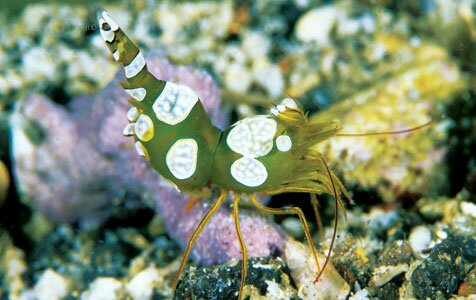Sexy Shrimp
From Microcosm Aquarium Explorer
Overview
This is a tiny shrimp that would fit comfortably on your thumbnail. It is characterized by its small size, opalescent white patches ringed in deep blue or purple, and green or tan as a base color. Its range is circumtropical.
Thor amboinensis is a hardy, wonderful little animal especially suited to small and nano aquariums without large, predatory fishes. In nature it is found living with sea anemones and large-polyped stony corals.
The Sexy Shrimp is fond of establishing residence on Bubble Corals and Euphyllia spp. It will adapt to various corals and anemones in the aquarium.
This is a gregarious species and best kept in pairs or groups of three or more. Five to seven Sexy Shrimp in a nano reef offer endless viewing opportunities.
They are called Sexy for their habit of provocatively lifting and waving their tails, as above.
Family: Hippolytidae
Other common name(s):
- Ambonian Shrimp
- Squat Anemone Shrimp
Native range:
Habitat: Typically found in reef and lagoon areas living with sea anemones or large-polyp stony corals.
Maximum length: 2 cm (1 in)
Minimum aquarium size: 8 L (2 gal)
Lighting: Moderate to high (for host coral or anemone).
Water: Marine 24 °C (75 °F) - 28 °C (82 °F)
Feeding
Will take small bits of meaty foods as fish are fed. May also feed on mucus from its host cnidarian.
Aquarium Compatibility
Excellent nano-aquarium species, but will often be lost in large tanks. Harmless. Preyed upon by a number of fish including anemonefishes.
Aggressive clownfishes, such as Clark's Clownfish, Amphiprion clarkii, do not tolerate them well and often kill them.
Special Care
If buying sight unseen, be ready: these shrimp are very small.
Notes
In the Caribbean, this tiny shrimp is often found on the Caribbean carpet anemone (Stichodactyla helianthus); in the Indo-Pacific, it may be found on most of the larger anemones.









